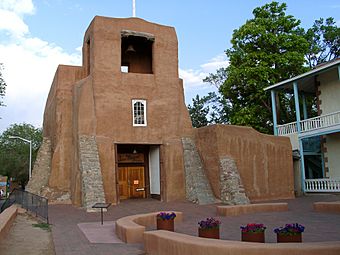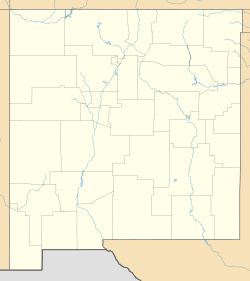Barrio de Analco Historic District facts for kids
|
Barrio de Analco Historic District
|
|
|
U.S. Historic district
Contributing property |
|

San Miguel chapel
|
|
| Location | Roughly bounded by E. De Vargas and College Sts., Santa Fe, New Mexico |
|---|---|
| Area | 18 acres (7.3 ha) |
| Built | 1620 |
| Architectural style | Spanish-Pueblo, Territorial architecture |
| Part of | Santa Fe Historic District (ID73001150) |
| NRHP reference No. | 68000032 |
Quick facts for kids Significant dates |
|
| Added to NRHP | November 24, 1968 |
| Designated NHLD | October 18, 1968 |
| Designated CP | July 23, 1973 |
The Barrio de Analco Historic District is a very old and important area in Santa Fe, New Mexico. It's a special place because it has some of the oldest homes in North America. These homes show how people lived and built houses long ago, even before New Mexico became a state!
This district includes two of the oldest buildings from the colonial era in the Southwest. One is the San Miguel Mission church, built in 1710. The other is the "Oldest House", which was built way back in 1620 and is now a museum. Because of its history, the district was named a National Historic Landmark in 1968.
Contents
What is the Barrio de Analco?
The Barrio de Analco is located on the south side of the Santa Fe River. It's across the river from the main part of downtown Santa Fe. That area includes the Santa Fe Plaza and the Palace of the Governors.
The district is centered around where Old Santa Fe Trail and East De Vargas Street meet. It stretches a little bit to the south, east, and west from there.
Important Buildings in the District
- The San Miguel Mission church is at the southeast corner of the main intersection. A church has stood on this spot since the 1610s.
- The "Oldest House" is at the northeast corner. This building was built in 1620 and is made of adobe.
- South of the mission is the Lamy Building. It's also called St. Michael's Dormitory. This school building was built in 1878. It shows off the "Territorial" style of architecture, which was popular before New Mexico became a state.
Other Historic Homes
West of the main intersection, you'll find the Gregorio Crespin House and the Roque Tudesqui House. Both of these homes were built in the Spanish Pueblo style. The Crespin House was built in the mid-1700s. The Tudesqui House is also likely from the 1700s.
Near the meeting of East De Vargas and Paseo de Peralta, you can see the Boyle House. This is another Spanish Pueblo building from the mid-1700s. The Bandelier House is also there. It was built in 1867 in the Territorial style. This house is special because the famous archaeologist Adolph Bandelier once lived there.
Where Did the Name "Analco" Come From?
The name "Analco" comes from the Nahuatl language. This language was spoken by the Tlaxcaltec people who came with the Spanish explorers.
The word "Analco" means "next to the water." In this case, it refers to the Santa Fe River. The Barrio de Analco was created shortly after Santa Fe was founded in 1609-1610. It was a neighborhood for artists, workers, and servants. The area north of the river was for the rich and powerful.
The buildings in this district show how architecture changed over hundreds of years. You can see everything from early adobe homes (like the "Oldest House") to the Spanish Pueblo style and then the Territorial style.
See also
 In Spanish: Barrio de Analco (Nuevo México) para niños
In Spanish: Barrio de Analco (Nuevo México) para niños



